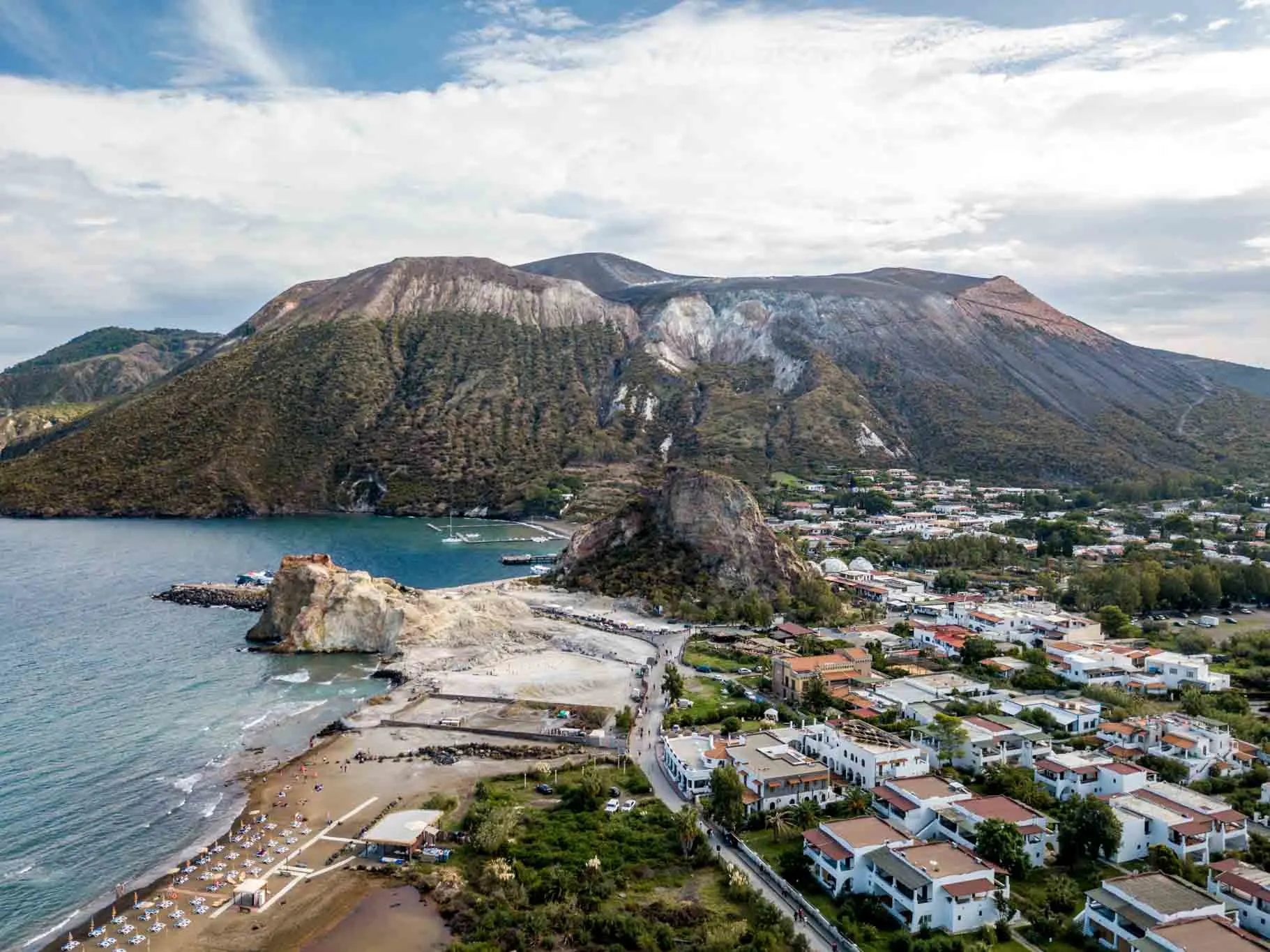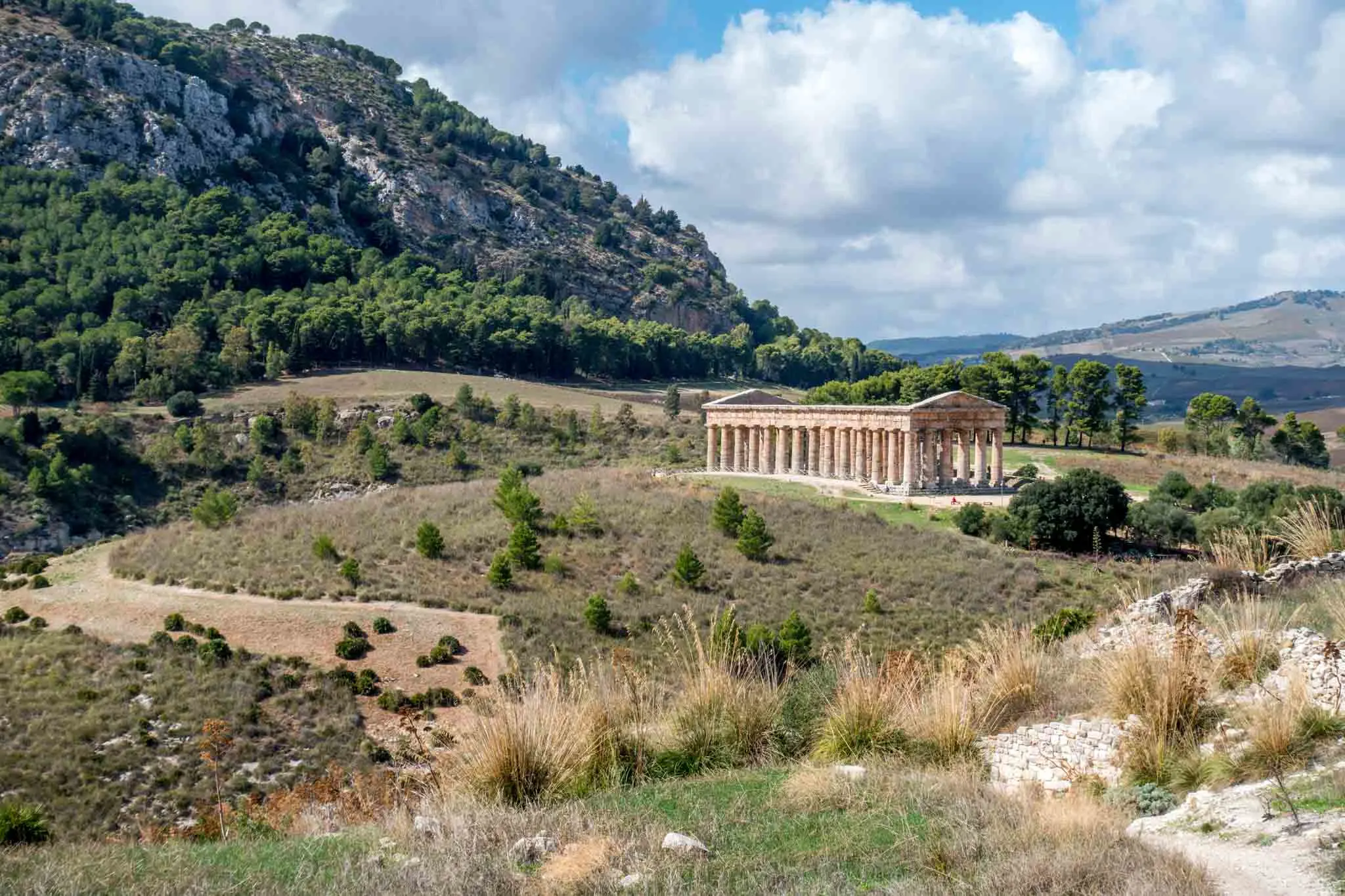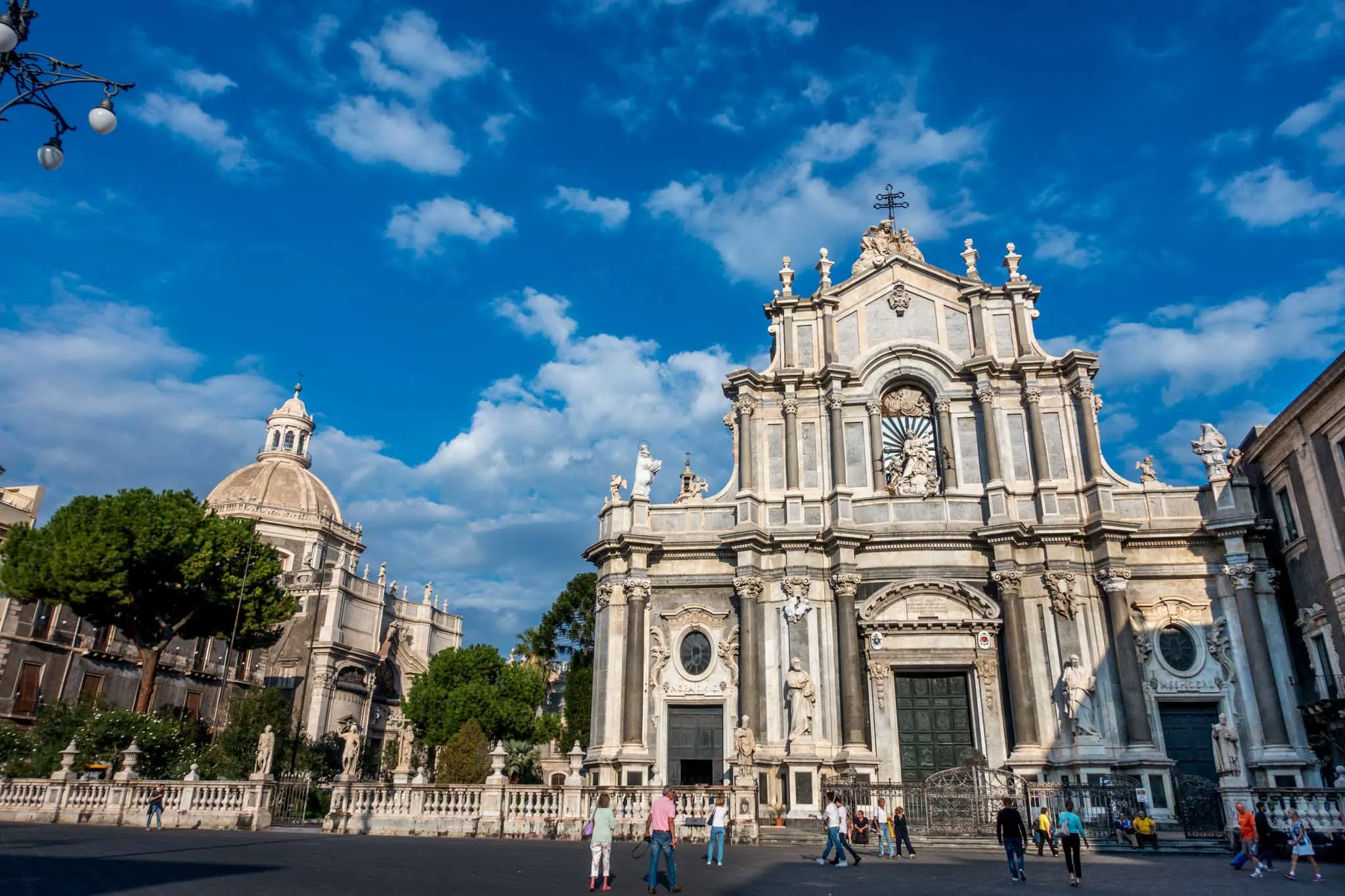Ancient ruins, incredible natural scenery, great food, and energetic cities combine to make Sicily an ideal destination. There is history stretching back over 3000 years, Michelin-starred restaurants, and plenty of opportunities to relax on a beach and do absolutely nothing. Here’s a look at some of the best things to do in Sicily to help plan your next vacation.
Walk through the Valley of the Temples

Visiting the Valley of the Temples in Agrigento is a must for lovers of history. The top attraction in Sicily, the complex is a UNESCO World Heritage site with lots of Greek ruins both above and below ground.
The six temples at the archaeological park, which were built between 510 BC and 430 BC, make it clear how wealthy the ancient town was in its prime. The star is the Temple of Concordia, the best-preserved Doric temple outside of Greece. The building continued to be used long after the Greeks left, which helps explain why it remains in relatively good shape 2500 years after it was built.
The Valley of the Temples offers different walking tours throughout the day, and you can buy tickets for them when you arrive. We joined a tour exploring the catacombs and death traditions of the people who once called this city home. The written descriptions at the attractions are sufficient, but having a tour guide is sometimes nice to understand the site more completely.
Sample Sicilian street food

Palermo is known for its inexpensive and delicious street food. The area near the city’s markets is full of places to buy some of the tastiest snacks.
Sample panelle (fritters made with chickpea flour); potato croquettes known as crocche; carduna, cacuocciuli e vruocculi (thistles, artichokes, and broccoli fried in butter); or crispy rice balls called aracine. Most stalls offer two traditional types of aracine—carne, which is stuffed with meat sauce, and burro, which is stuffed with béchamel sauce with cheese and ham.
Our favorite was sfincione, a thick bread, topped with tomatoes, onions, and a bit of oregano. If you’re feeling much more adventurous than we were, try out pani ca’ meusa—a veal spleen sandwich.
See the grandeur of Monreale Cathedral

Just a half-hour from Palermo, the Monreale Cathedral is one of the most impressive things to see in Sicily. This stunning building, which was built in the 12th century, is part of the collective UNESCO World Heritage Site of Arab-Norman churches. It has 130 mosaic scenes and 200 carved columns. The scope of it is hard to describe.
The standout among the glittering tile is the massive 65-foot-tall mosaic of Christ Pantocrator over the altar. It is estimated to be covered in over 2 tons of gold. Even if you’re not into visiting a lot of churches, the Monreale Cathedral is absolutely worth a stop.
Explore the Ancient Theater of Taormina

In its prime, the Ancient Theater of Taormina regularly welcomed thousands of visitors to see performances and gladiatorial games. Built in the 3rd century BC, it offers some of the best views on the island from its perch high on a hill in northeastern Sicily. From the top of the theater, you can look out over the Mediterranean, and on a clear day, you can see Mount Etna rising in the background.
Since the 1950s, the theater has hosted ballet performances, operas, and Greek tragedies, among other events. The Taormina Film Festival fills its seats every year, and performers like Elton John and Sting have graced its ancient stage. If you can’t attend one of the special events, you can still explore the theater on a self-guided tour daily. The crowds can be intense during high season, so it’s best to go early in the day.
Visit Mount Etna

The largest active volcano in Europe, Mount Etna is one of the most intriguing places to visit in Sicily. There are lots of different ways to explore the commanding mountain depending on the season, your interests, and how active the volcano is at the time.
Several companies offer half- or full-day guided tours, plus you can hike on your own in the summer or visit one of the ski areas in the winter months. One of the most popular ways to visit Mount Etna is via cable car followed by a ride in a 4×4 bus to just below the summit. Seeing the craters is intriguing, and the panoramic views are incredible.
Try Marsala at a local winery

One of the most recognizable wines in Sicily comes from the town of Marsala. For years, the golden wine of the same name, Marsala, had a reputation as being overly sweet and not of the best quality, but all of that has changed in recent decades. A visit to Marsala is a perfect opportunity to visit a winery to learn just how good the product can be.
Many wineries in Marsala offer tours and tastings by advance reservation. We were lucky to join a tour at Cantine Pellegrino, one of the best and oldest wineries, which is now in its sixth generation of family ownership.
On a tour here, you will learn about grapes, the history of wine-making, and the Pellegrino family’s long involvement with the production of this fortified product. Our tour culminated with sampling three of Pellegrino’s best wines straight from the giant wooden barrels where they age. If you like similar products such as Port wine, a stop here should definitely be on your list of things to do in Sicily.
Visit the salt pans near Trapani

As you drive along the coast between Trapani and Marsala, the ocean comes right up to the road, and harvested salt rests in piles in the shadows of the red-topped mills. The scenery is so perfect that it almost looks like a movie set. But everything here is functional, operating in the way it has for generations and producing salt in the same pans that have been used for nearly 3000 years.
If you want to learn more about salt, visit the Museo delle Saline (aka Salt Museum). Its detailed exhibits show how salt is made from pumping in the ocean water through evaporation and raking, and you can see the mill at work on certain occasions. Climbing to the top of the mill provides gorgeous views of the salt flats and the sea, but unless you have a particular interest in all things salt, the museum is skippable. Instead, stop for a meal or a drink at the restaurant and enjoy the view.
Appreciate the beauty of Cefalu

If you visit Sicily outside the peak summer season, the beautiful town of Cefalu is a perfect destination (in season, it can be somewhat overrun with visitors). The coastal town is ideal for leisurely strolling between the squares and other pedestrian areas, dipping your toes in the sea, and people watching along the promenades. From the moment we arrived here, we started to plan a return visit.
Situated at the base of a massive rock, the scenery here is dramatic. The honey-hued buildings at sea level are full of shops and restaurants, and there is lots of striking architecture.
One of the biggest draws in town is the Duomo di Cefalu, which is designated as a UNESCO World Heritage site because of its architecture and mosaics. Begun in 1131 by the Normans who ruled Sicily at the time, the cathedral looks like a fortress on the outside but houses outstanding religious art on the inside.
Eat Sicily’s best cannoli in Erice

Sicily is the birthplace of cannoli, and nowhere does it better than Maria Grammatico’s pastry shop (La Pasticceria Maria Grammatico) in Erice. Sent to live in a convent at 11 years old, Grammatico learned the art of making pastries from the nuns whose recipes date back centuries. Today, she is famous worldwide for her cannoli, almond-based pastries, and marzipan. Enjoy one of the treats in the café or get one to go and eat it on the benches outside while you take in the beauty of Erice.
Discover historic Syracuse
One of the most powerful cities in the ancient world, the origins of Syracuse date back to 734 BC when its historic center, Ortygia, was settled. Evidence of that 3000 years of history is everywhere as you explore this intriguing city.
You can walk in the steps of Aeschylus, the father of Greek tragedies, at the massive Greek Theater of Syracuse or marvel at the 2500-year-old columns from the Temple of Athena that are now part of the city’s cathedral. Visit the preserved Roman amphitheater, see how softly you can whisper at the Ear of Dionysus, or just window shop in the ancient lanes and people watch in the piazzas—there is no wrong way to enjoy your time in this stunning place.
Visit the Aeolian Islands

Just off the northern coast of Sicily are the seven main Aeolian Islands—Lipari, Vulcano, Salina, Panarea, Stromboli, Filicudi, and Alicudi. Each has its own personality and different things to do. It’s possible to visit some just for the day, or you can book a hotel to linger a little longer.
The volcanic islands boast black sand beaches, volcanic craters, wineries, and historic sites, among other attractions. You can see the regular eruptions of Stromboli volcano, shop and visit museums on Lipari, or enjoy a spa and eat at a Michelin starred restaurant on Vulcano. It’s worth it to visit at least one of the islands if you have the time in your Sicily itinerary.
Marvel at the Palatine Chapel

Nearly 900 years ago, Roger II commissioned the Palatine Chapel to be the royal chapel at the Palace of the Normans. The grand space, which is one of the top things to see in Palermo, was finished in 1143. Its stunning design still impresses thousands of visitors every day.
The brightly colored mosaics that grace the arches and walls are accented with gold leaf and inlaid with precious stones. They illustrate various Old Testament stories and show Jesus as the Pantocrator in the gleaming tiles over the altar. The painted wooden ceiling has a clear Arabic influence, which is unique in a Christian church. From floor to ceiling, there is something remarkable in just about every square inch of the room.
Explore the markets of Palermo

Palermo’s three city markets are a delight to visit. The energy is fun, the colors are vibrant, and the smells pouring forth from the restaurants and food stands are mouthwatering. Located in the city center, they are within about 15 minutes’ walk of each other.
The most famous food market is Ballaro where vendors communicate with each other in a sing-song way that rings throughout the market and makes for a unique experience. It is packed with fresh produce and meats, unique spices, and lots of street food. If you only have time to visit one market, Ballaro is a must see.
At the Capo market, you’ll find a wide selection of produce and lots of people waiting to cook for you—whether it’s to sell their offerings or cook up the seafood or meat you bought a few stalls down. Nearby, La Vucciria has fresh food as well as lots of flea market-type merchandise, so be on the lookout for treasures.
See the majestic ruins of Segesta

The isolated ruins of Segesta sit on a hilltop in western Sicily. Once a major city of the Elymians—a civilization who inhabited the area for centuries during the Bronze Age—its architecture is all that remains today.
The structures that are left from the ancient city are some of the best-preserved Classical monuments in the world. The Doric Temple at Segesta, which dates from around 430 BC, was never completed, but its 28 massive columns still stand as a testament to how important the city once was. Nearby, a theater that dates from the 2nd century BC has spectacular views of the of the Gulf of Castellamare and still hosts events during the summer.
See the Baroque towns of Val di Noto

In 1693, a major earthquake leveled much of southeastern Sicily. Many of the towns were rebuilt in the Sicilian Baroque style of architecture, which is characterized by curves, flourishes, and rich ornamentation. From intricate balconies and inlaid marble to faces that peer out at you from the facades of buildings, the decorative elements are remarkable.
Walking through these rebuilt towns and cities feels like a step back in time because so many of the buildings date from the early 1700s. The similarity and artistic nature of the buildings have landed eight towns in Val di Noto a spot in the UNESCO World Heritage list.
Catania, Sicily’s second largest city, is a popular stop for many visitors because of its international airport. Take the time for a walking tour through the city and don’t miss the festival of seafood that is the fish market that happens every morning and early afternoon Monday through Saturday. Visit the nearby Piazza del Duomo and see the unusual elephant fountain and the Duomo itself.
About an hour away, the towns of Ragusa, Noto, and Modica are also beautiful places to visit. Explore the upper and lower towns in Ragusa, step inside Ragusa Cathedral, and see the blue dome of the bell tower at Santa Maria dell’ Itria. In Noto, don’t miss San Nicolo Cathedral and the views from the terrace at porticoed Palazzo Ducezio. In Modica, try the famous chocolate based on an ancient Aztec recipe, and enjoy the many unique churches and cathedrals.
Laura Longwell is an award-winning travel blogger and photographer. Since founding Travel Addicts in 2008, she has written hundreds of articles that help over 3 million people a year get the most out of their travel. In that time, she has visited nearly 60 countries on 5 continents, often returning to favorite destinations over and over again. She has a deep love of history, uncovering unexpected attractions, and trying all the good food a place has to offer.
In addition to Travel Addicts, Laura runs a site about her hometown of Philadelphia—Guide to Philly—which chronicles unique things to do and places to see around southeastern Pennsylvania. Her travel tips and advice appear across the web.
